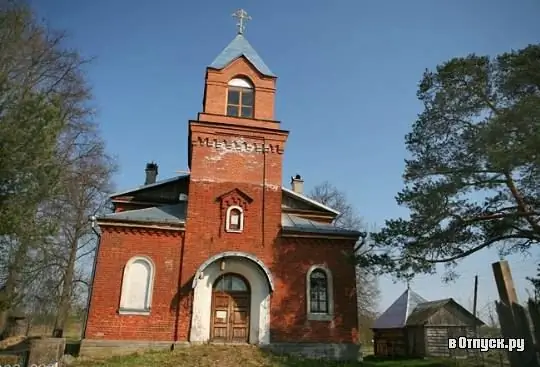
Description of the attraction
The Church of the Holy Great Martyr Theodore Stratilates is located in the village of Kiselnya, Volkhovsky District, Leningrad Region. The Pesotsky Fedorovsiy pogost, on which the church was built, was located not far from Staraya and Novaya Ladoga. The church was located on the right bank of the Peschanka River, surrounded by fields and clergy houses.
The mention of this church is found in the scribes of the 16th century. 267 years after the construction (in 1768), the wooden church of Theodore Stratilates due to dilapidation, it was decided to dismantle, and instead build a new one with the same name, but with the side-chapel of the Savior Not Made by Hands. The main church was consecrated on June 7, 1771, the chapel - on June 8, as evidenced by the inscriptions on the altar crosses. The consecration of the temple was carried out by Georgy Moiseev, archpriest of the Novaya Ladoga Cathedral.
In 1858, on the site of the bell tower, which stood separately from the church, a new one was built, which formed a single building with the temple. A wood shed was made from the old bell tower. In 1877, at the expense of the temple, it was covered with an iron roof.
In the temple of Theodore Stratilates there are old iconostases; on many icons, the faces have worn out, blackened, or even disappeared from the gilding. The temple is 2 sazhens in height; and the bell tower is 12 fathoms; the length of the main temple is 8 fathoms; the length of the side-altar is 5 fathoms.
On June 19, 1853, Bishop Christopher consecrated the Antimension of the main church. The following items were in the church: the icon of Nicholas the Wonderworker (it contains particles of the relics of Nicholas the Wonderworker, a finger with the "blood of the Lord" dripping on it, the relics of John the Baptist, the Apostle Andrew, Theodore Stratilates and three ecumenical hierarchs, the icon was donated in 1850 by an honorary citizen of St. Petersburg M. A. Ikonnikova); sacred pewter vessels; The Gospel, published in 1751 in Moscow, is overlaid with green velvet and decorated with silver; a miscellany published in 1676; a church charter signed by Archbishop Gabriel and issued from the Holy Trinity Alexander Nevsky Monastery in 1768; facade and plan of the church and area.
Since 1843, the clergy consisted of a priest, a sexton, a sexton and a broth. Among the priests are known: Terenty Nikiforov, Nikifor Ioannov, Simeon Trifonov, Ioann Simeonov, Evfimy Dolotsky, Nikolai Lebedev. At first, it was supported by income from the demand. The clerk was located in two church houses. Since 1855, there was a school attached to the church, which was located in the church gatehouse. The priest Euthymius Dolotsky had 20 students there.
In 1903, the church burned down. A church that was built in 1906 has survived to this day. Architects - Yankovsky, Pilts, Romanchenko.
Description added:
irina 12.03.2018
During the war, there was a hospital in the church building. After the war - the grain warehouse of the collective farm "Bolshevik". In the 70s-80s - the club of the state farm "Cha
Show all text During the war, there was a hospital in the church building. After the war - the grain warehouse of the collective farm "Bolshevik". In the 70s-80s - the club of the state farm "Chaplinsky". Then in the building of the church there was a woodworking shop.
Hide text






